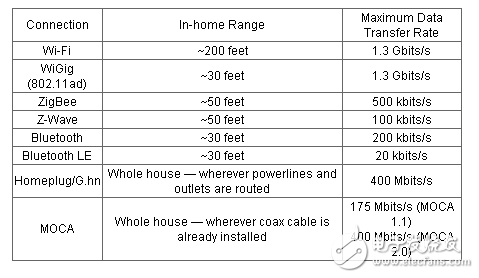
资料下载

智能住宅越来越接近无线解决方案提供连接
智能住宅越来越接近无线解决方案提供连接
未来的智能和连接的家,一个可以控制所有的设备,提供通信,感觉乘员的存在,控制入口和出口点,和更多,越来越接近。虽然一个完整的解决方案还很遥远,位和智能/家庭连接件已经开始出现,无线网络,让用户将音频和视频内容的计算机连接到互联网和其他各种电器,链接,和监控的房子当他们离开。越来越多的电器和安全产品也获得了网络接口,其中包括灯、窗帘、照相机和门锁,以及加热和冷却系统。
不幸的是,似乎有许多连接解决方案,因为有连接设备。各种无线技术目前在国内包括Wi-Fi各品种(802.11 A,B,G,N,和AC),蓝牙和蓝牙低能量、Z-Wave、ZigBee、WiGig(802.11ad),和一些专有的无线接口。此外,尽管MoCA(同轴电缆多媒体联盟)协议以及G.hn和HomePNA使用电线,他们实际上没有增加任何新的电线的房子;相反,他们使用现有的同轴电缆从有线电视系统或家庭现有的电力线来传输媒体内容或控制命令。简单的适配器在同轴电缆或电力线和基本上是主干网的无线或有线以太网之间架起了一座桥梁。

The connectivity choices available to designers span multiple technologies, and each technology has different characteristics that can be leveraged. Therefore, a smart home does not need to be a “unified” system that uses only a single standard, but can be built using multiple wireless technologies that complement each other rather than compete with each other.
Table 1 summarizes ranges of various network interfaces, as well as some of the limitations and synergies that the most popular connectivity options provide. For example, in a large house, Wi-Fi signals may not be able to reach from one end to the other, so either a signal booster/repeater will be needed. By using either MOCA or powerline adapters, data can be sent over the powerline or coax cable and then, in the remote location, a small adapter can siphon the data signal off the coax cable or powerline and convert it back into a Wi-Fi (or other standard wireless) signal. The two technologies become synergistic and do not necessarily compete with each other.
声明:本文内容及配图由入驻作者撰写或者入驻合作网站授权转载。文章观点仅代表作者本人,不代表电子发烧友网立场。文章及其配图仅供工程师学习之用,如有内容侵权或者其他违规问题,请联系本站处理。 举报投诉
- 相关下载
- 相关文章







